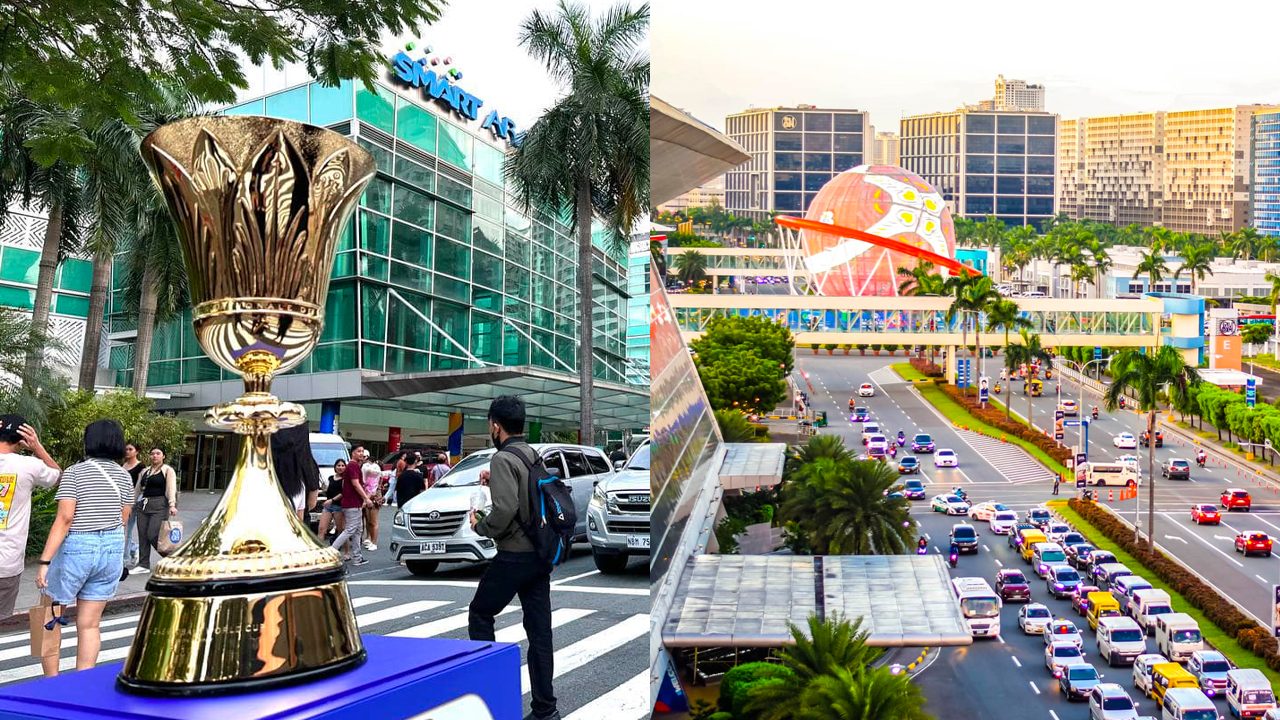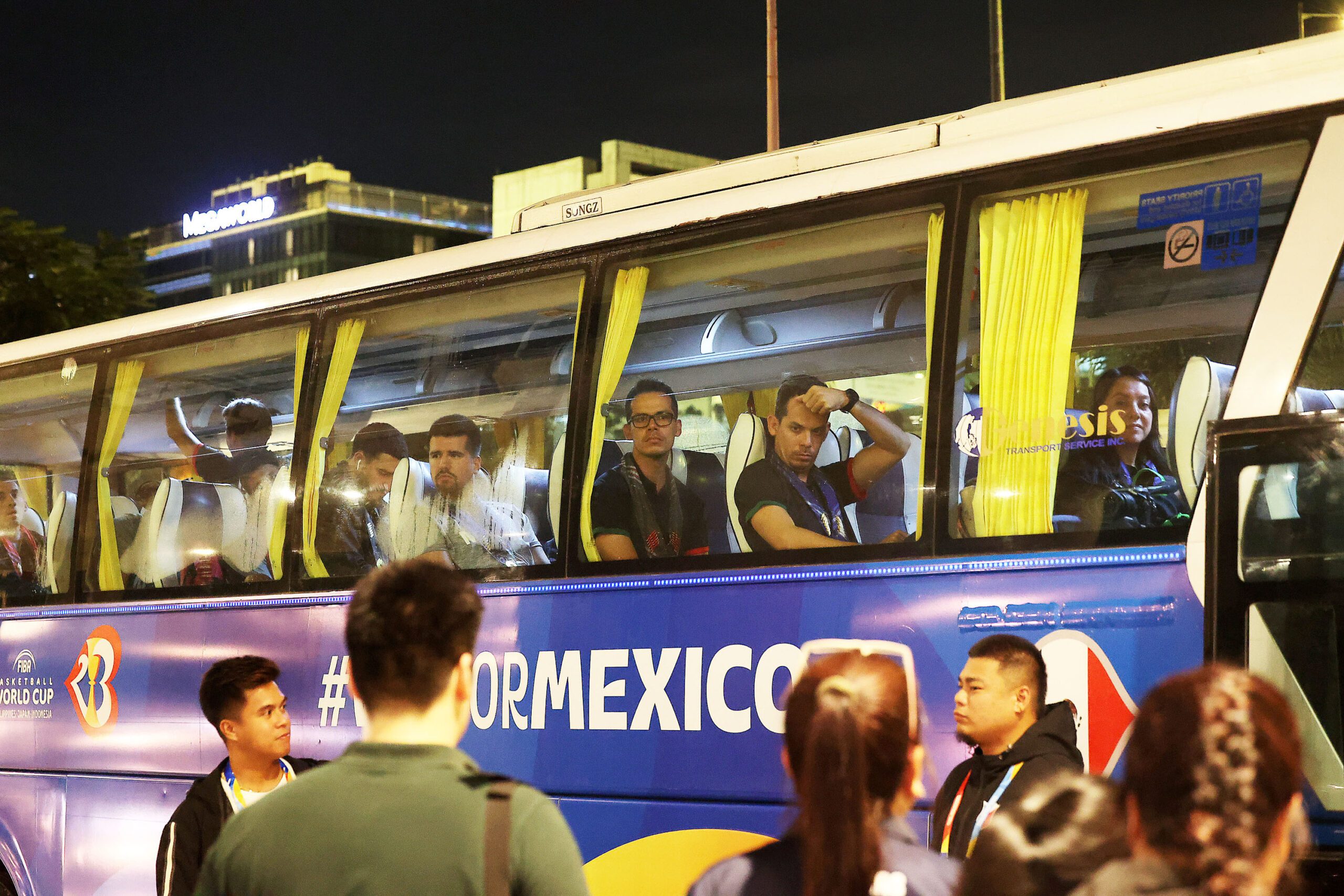SUMMARY
This is AI generated summarization, which may have errors. For context, always refer to the full article.

MANILA, Philippines – Despite a disappointing performance on the basketball court, there is cause to celebrate for what has been – so far – the Philippines’ commendable hosting of the FIBA Men’s Basketball World Cup 2023.
Although Gilas Pilipinas won only one of five games in the tournament, the country’s economy has gotten a boost from its hosting of the biggest stage of the world’s most popular indoor sport. The global event is giving the country a much-needed infusion following three years of constrained business activities during the COVID-19 pandemic.
“It’s both a privilege and honor to host the World Cup,” said tycoon Manny V. Pangilinan prior to the games, noting that Filipino fans only saw FIBA World Cup games on screens after it last hosted the tournament 45 years ago or in 1978.
Pangilinan, also known as MVP, the Philippines’ most prominent sports patron, worked hard with other sports leaders in winning hosting rights for the Philippines back in December 2017. FIBA ended up awarding it to three countries – Japan, Indonesia, Philippines or JIP – under a multi-country hosting set-up, the first time for such a format for the World Cup.
The Philippines is host to 16 teams in the first two rounds, while Japan and Indonesia is hosting 8 each. The final phase of the World Cup (from quarter finals to the final game), which is expected to bring in more foreign spectators to the country with the addition of 4 teams (2 from the Japan hosting and 2 from the Indonesia hosting), will be held in Manila from September 5 to 10.
The national teams of Germany and Slovenia from Japan’s hosting, and Canada and Latvia from Indonesia’s hosting are coming to Manila to play in the quarter finals to finals phase at the SM Mall of Asia (SM MOA) Arena this week.
Aside from the three stadiums used in the games – SM MOA Arena, Araneta Coliseum, Philippine Arena – among the big winners so far in business are those involved in hotels and malls, food, transportation, media and telecommunications, and security.
Philippine companies such as diversified conglomerate San Miguel Corporation have also contributed in a major way to the Philippine hosting.
San Miguel Corporation President and CEO Ramon Ang set aside his rivalry with Pangilinan in the Philippine Basetball Association (PBA), where he has three teams, and supported the hosting via San Miguel Brewery Incorporated, particularly his beer brand San Miguel Pale Pilsen.
“We are very proud to have been given this rare opportunity to host the FIBA Basketball World Cup. I think it’s the best time to have a prestigious international competition in the Philippines. After almost three years of the pandemic, we want to say that we are open for business, Filipinos are excited to welcome athletes from all over the world, and we are all eager to watch the very best teams play in our homecourt,” Ang said in a statement in April.
“This is also one of the times when our country can take center stage and show to the world what we are capable of doing. Definitely, hosting the FIBA World Cup is one of those golden opportunities and a privilege,” he added.
The owners of SM Mall of Asia (MOA) Arena in Pasay City and Araneta Coliseum in Quezon City spruced up the facilities of the two stadiums for the FIBA World Cup.
“Hosting the FIBA Basketball World Cup is a momentous highlight for us and for the country this 2023. We made all the necessary adjustments and improvements to make this once-in-a-lifetime event memorable for all players and audiences at the City of Firsts,” Irene Jose, COO of Uniprom Incorporated, the entertainment arm of the Araneta Group, said.
The Big Dome’s basketball flooring, backboard, rims, and shot clock were replaced in time for the global basketball event. The coliseum now has a new and bigger LED scoreboard cube to give a “larger-than-life view of on-court action and updates,” said Araneta Center management. In addition, the dugout rooms were renovated, and audience seats refurbished.
Araneta Coliseum was the venue of the 1978 FIBA World Cup semi-final and final game, where Yugoslavia defeated the then-Soviet Union for the title.
One advantage of the Philippines in co-hosting is that the Philippine government didn’t have to spend taxpayers’ money to build the stadiums for the World Cup.
All three stadiums had already been built by private entities. There’s also no risk of these turning into white elephants, as some countries which hosted major sporting events had experienced. SM MOA Arena and Araneta Coliseum are already sustainable business ventures.
With respect to SM MOA, Mark Solano, the venue head designated by the FIBA Basketball World Cup Local Organizing Committee, identified some of the upgrades:
- A new players’ entrance was constructed for faster access from the bus drop-off area to the changing rooms; seats were refurbished, walls were repainted, and the dugouts were dressed up.
- All the toilets and cubicles were upgraded and with new tiles; shower heads that can accommodate 7-footers were installed.
- At the second floor, a Naismith Lounge was put up for VIPs, where they have privacy and comfort.
- An area for media that can accommodate 328 foreign and local journalists was built, with the actual working area ready to service 252 reporters and photographers and a spacious media catering area.
- Shops to purchase souvenirs were also installed in designated areas at the concourse.
Traffic going to and leaving SM MOA was pre-coordinated with the Pasay LGU and police, the MOA Arena management, and the Local Organizing Committee’s (LOC) own security and transport teams for smooth flows.
In the run-up to the tournament, Pangilinan’s Smart Communications Incorporated also transformed the MOA Ball into a giant basketball with a hoop, employing around 250 workers for the installation.
With the Philippines as host of 52 out of the 92 games involving 32 teams, around 600,000 spectators, both local and foreign, were expected, according to the Department of Tourism. That’s over half a million people spending money on tickets, food, transportation, lodging, local tours, hoops souvenirs, telco services, and shopping.
Assuming 100,000 foreigners spent $150 daily for two weeks, that’s equivalent to a P210-million boost for the economy, excluding the money spent by Filipino fans.
When China hosted the 18th edition of FIBA World Cup in 2019 in 8 cities, the total number of spectators reached 794,951, an average attendance of 8,641 per game, according to a FIBA Mid-Term Activity 2019-2022 report.
The FIBA Local Organizing Committee (LOC) International Relations told Rappler that around 1,800 official FIBA delegates are in town for the quadrennial event. In addition, there are 25 delegates from co-host Indonesia’s LOC, 15 from co-host Japan’s LOC, and 21 from Qatar, the next host of the FIBA World Cup in 2027.
Opening day record, fans
Another source of pride is that the Philippines made basketball history by breaking the FIBA opening games attendance record of 32,616 set in Toronto, Canada in 1994, with at least 38,115 at the Philippine Arena, Bulacan on August 25.
The organizers also opted for local acts such as Sarah Geronimo, Ben & Ben, The Dawn and other Filipinos instead of foreign performers at the tournament’s opening, a boon to the Philippine entertainment industry.

“We see the FIBA Basketball World Cup as an opportunity, first and foremost, to reintroduce the Philippines to the world on the strength of our natural cultural assets, our award winning destinations, our emerging cities and municipalities all over the Philippines,” Tourism Secretary Christina Garcia Frasco said at a news conference prior to the start of the tournament.
Fans of the teams have been cheering for their nationals in the two main stadiums, with 12th-ranked Lithuania having a particularly strong presence in the stands.
Foreign and local visitors for the FIBA World Cup are keeping hotels near SM MOA in Pasay, Araneta Center in Quezon City, and other major hotels in Makati, Taguig, Pasig, and Mandaluyong busy these days.
Around 400 buses are being used to transport members of the team and official delegates and support staff.

Except for a security breach at SM MOA involving a fan dressed up as part of the New Zealand delegation, there have been no security problems so far.
Pre-World Cup activities
The FIBA-related economic activities started way before August.
The World Cup 2023 draw was held last April in Manila at the Araneta Coliseum, with ex-Dallas Mavericks star Dirk Nowitski visiting the Philippines for the first time.
A FIBA Basketball World Cup tour displaying the Naismith Trophy was also held in Cebu, Davao, Manila, and Ilocos Norte from August 14 to 23.
The FIBA World Congress was held in Manila on August 23 to 24, with around 350 participants from the FIBA Central Board members, delegates from 212 national federations, and Local Organizing Committee guests.
On day 2 of FIBA Congress at Sofitel Manila, Filipino basketball legend Carlos “Caloy” Loyzaga was posthumously inducted into the Hall of Fame with 11 others who have contributed greatly to the sport. They include Yao Ming (China), Penny Taylor (Australia), Yuko Oga (Japan), Katrina McClain (USA), Amaya Valdemoro (Spain), Wlamir Marques (Brazil), Angelo Monteiro dos Santos Victoriano (Angola), Sony Hendrawan (Indonesia); Zurab Sakandelidze (Georgia) plus coaches Valerie Garnier (France) and Alessandro Gamba (Italy). Loyzaga is the first Filipino in the Hall of Fame.
As the World Cup moves to the final phase next week, hopes are up that even though there’s been a lack of chemistry from Gilas Pilipinas on court, Philippines Incorporated will continue to show it has both “puso” (heart) and enterprise in hosting the biggest basketball event in the world. – Rappler.com
Add a comment
How does this make you feel?

![[EDITORIAL] Apat na taon na lang Ginoong Marcos, ‘di na puwede ang papetiks-petiks](https://www.rappler.com/tachyon/2024/07/animated-bongbong-marcos-2024-sona-day-carousel.jpg?resize=257%2C257&crop=280px%2C0px%2C720px%2C720px)
![[In This Economy] Delulunomics: Kailan magiging upper-middle income country ang Pilipinas?](https://www.rappler.com/tachyon/2024/07/in-this-economy-upper-middle-income-country.jpg?resize=257%2C257&crop=421px%2C0px%2C1080px%2C1080px)

![[EDITORIAL] Marcos Year 2: Hilong-talilong](https://www.rappler.com/tachyon/2024/07/animated-bongbong-marcos-2nd-sona-carousel.jpg?resize=257%2C257&crop=136px%2C0px%2C720px%2C720px)
![[Newspoint] A fighting presence](https://www.rappler.com/tachyon/2024/07/thought-leaders-a-fighting-presence.jpg?resize=257%2C257&crop=441px%2C0px%2C1080px%2C1080px)





There are no comments yet. Add your comment to start the conversation.